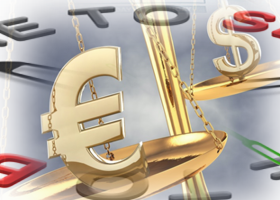How China controls the yuan
Keeping track of how the People's Bank of China uses a “managed floating” exchange rate system is challenging: the central bank has a variety of instruments, both public and hidden, at its disposal.
The train of thought of the Chinese Central Bank is incomprehensible to the uninitiated, but you can watch his attempts to influence the currency. Some measures are not as obvious, such as Beijing's plans to cut liquidity to support the yuan, and some have become more predictable and transparent over the years, such as the daily base rate. The so-called fix, which has long been seen as a political signal for regulating the Chinese exchange rate, recently reached levels that were in line with the average estimates in Bloomberg polls. This suggests that the authorities are allowing the market to further influence the yuan.
Here are some other ways to help you understand NBK policy:
Daily fixing
The most obvious way the NBK can influence the currency is by setting the base rate every trading day at 9:15 am Beijing time - the daily fix. The yuan can then move 2% in any direction. Rates are calculated using formulas that take into account factors such as the previous day's official close at 4:30 pm, the movement of the yuan against a basket of currencies, and changes in other major exchange rates. Accordingly, the encouraging decline at the official close allows the central bank to charge lower rates without sending a clear policy signal or destabilizing markets.
To understand what the signal behind the fix means, you need to compare it with market expectations. Minutes before the commit, Bloomberg is to release the average estimate based on a survey of currency analysts and traders. A base rate that is significantly stronger or weaker than expected is usually considered a signal from Beijing.
Over the years, this system has undergone several changes that have helped make it more transparent and market-oriented. Here are some of the milestones in the evolution of the course:
- January 2006: China allows the yuan to trade within 0.3% versus the US dollar against a fixed rate
- May 2007: China expanded the yuan trade range to 0.5% in both directions from the fixed rate
- April 2012: NBK expanded its trading range to 1%
- March 2014: Trading range increased to 2%
- August 2015: China devalued the mainland yuan in the largest currency reform in a decade. In an effort to make the rate setting process more transparent, the NBK identified factors that banks should take into account when submitting price data to determine the rate.
- From 2017 to 2020: a countercyclical factor was introduced and then eliminated in the fixation formula several times, as Beijing sought to ensure the sustainability of the yuan through cycles of devaluation and growth
Countercyclical factor
In 2017, the NBK introduced a so-called “countercyclical factor” into the formulas that commercial banks use to calculate the indicators that are taken into account when setting Beijing's daily base rate. This was done to avoid an overly weak fixing rate. He removed this component in January 2018, when the yuan began to skyrocket. After about seven months, this factor was again used to limit weakening. And in October 2020, lenders said they had recently stopped using it.
Verbal warning
The NBK's standard currency position assumes that "overall, the yuan will be maintained at a reasonable, equilibrium level." However, Chinese officials may well push the currency up or down by making statements when necessary. For example, in October 2019, the head of Yi Gang Bank said that the currency was at an “appropriate level” to slow down the depreciation of the yuan at that moment.
Capital controls
Controlling cash inflows and outflows is one of the most unambiguous tools. China has taken measures to curb capital outflows following the devaluation of the yuan in 2015, imposing strict restrictions on everything from foreign takeovers of Chinese companies to consumer purchases of insurance policies in Hong Kong. At the same time, the government seeks to stimulate capital inflows. In September, it expanded the range of investment opportunities available to foreigners through the Qualified Foreign Institutional Investors and Qualified Foreign Institutional Investors in RMB programs.
Foreign exchange reserves
China also owns the world's largest foreign reserves - more than $ 3 trillion. Politicians sold billions of dollars after the 2015 devaluation to prop up the yuan. (This stock has recently stabilized.) This may be a useful indicator, but it is also affected by the massive rise in the dollar, which could lead to a reduction in China's declared reserves. This is not necessarily the result of intervention, but rather a consequence of the depreciation of non-dollar assets in China's holdings against the dollar.
Reduced liquidity
Raising the value of rates against the yuan in offshore regions has long been considered the preferred tactic when China wants to curb declines. The main challenge is to drain the liquidity streams: Hong Kong is by far the largest market, so traders will have to pay higher interest rates to borrow the yuan. This is due to the fact that agent banks buy currency or refuse to lend it to other banks. The NBK may also sell Chinese Treasury bills in Hong Kong. Over the past few years, the interbank overnight offer rate, known as Hibor, has climbed more than 20% on several occasions, most notably in January 2016, when it rose to nearly 67%. Another contraction occurred in August 2018, when the value of the rate on the fall of the yuan jumped sharply amid speculation that


